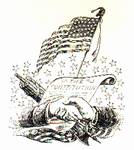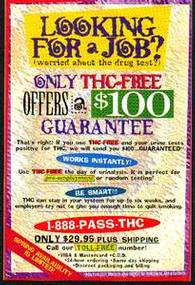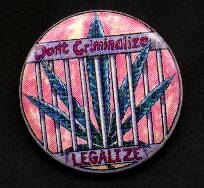That's Sheriff Mack who said "Leave
people alone and live and let live."
Stop the war on drugs. End hemp prohibition now.
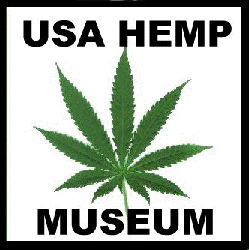 |
HEMP LEGAL
MATTERS
USA Hemp Museum
Store |
|
THE 1937 MARIJUANA TAX STAMP ACT |
ROOM GUIDE |
|
||||||||||||||||
|
1. WELCOME TO THE HEMP LEGAL MATTERS ROOM.
Hemp the Cannabis sativa plant, was legal for all uses to U.S. Citizens before the Marijuana Tax Act of 1937. What happened? How did the government take control of drug policy? How did the Prohibition of intoxicating liquor fit in to the story? What are the present arguments made to justify federal government control of drug policy? How are the laws changing? So many questions need answers. The movement to re-legalize the hemp plant has had several surges in the past 63 years, including its use in World War II, the sixties revolution, the re-discovery of industrial uses of hemp and the Medical Marijuana movement. Included in this section you will find some of the artifacts of the effort to re-legalize the plant, buttons, bumper stickers, posters, fliers, pamphlets and books that the museum has collected.
THE DRUG WAR IS A WAR ON WE THE PEOPLE
New National Anthem To Stop The War On Drugs
Michael Jackson - They Don't Care About Us (Prison Version)
Thank you Michael Jackson for this liberation anthem
The War on Drugs Has Failed. Is Legalization the Answer?
The Attorney General said he would cease raiding medical marijuana clubs.
What about the rest of us?
Can we grow hemp?
Can we use hemp to help solve our problems now?
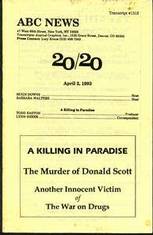 |
The legal nightmare of hemp
prohibition went on long enough to cause the home invasion
murder of Donald Scott.
No drugs were present. The various police agencies had already divided up Scott's 4 million dollar property on paper. These tactics over a relatively harmless plant are an outrage. The government will only be stopped with re-legalization of hemp, all hemp. |
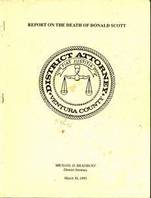 |
The Ventura County District Attorney's REPORT ON THE DEATH OF DONALD SCOTT. March 30, 1993. |
 |
We have solutions to the "drug war." We have the precedent of the first prohibition, which ended one day in 1933. Prohibition II will end one day, also. |
|
"The general rule is that an unconstitutional statute, though having the form and name of law, is in reality no law, but is wholly void...its unconstitutionality dates from the time of its enactment...No one is bound to obey an unconstitutional law and no courts are bound to enforce it." -16 Am Jur 2d 177 |
 |
And where did the money go? |
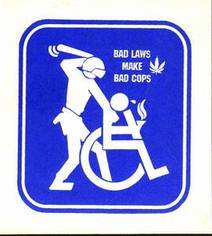 |
Our elected officials make the bad laws as well as the good ones. We need jury nullification to help get rid of bad law. |
 |
Question authority! |
Bob Marley On Hemp
|
The only freedom
which counts is the freedom to do what some other people think
to be wrong. There is no point in demanding freedom to do that
which all will applaud. All the so-called liberties or rights
are things which have to be asserted against others who claim
that if such things are to be allowed their own rights are
infringed or their own liberties threatened. This is
always true, even when we speak of the freedom to worship, of
the right of free speech or association, or of public assembly.
If we are to allow freedoms at all there will constantly be
complaints that either the liberty itself or the way in which it
is exercised is being abused, and, if it is a genuine freedom,
these complaints will often be justified. There is no way of
having a free society in which there is not abuse. Abuse is the
very hallmark of liberty.
-Former Lord Chief Justice Hailsham, "The Dilemma of democracy" E-mail from Peter Webster |
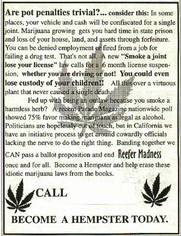 |
A 1994 call for help. "...in California we have an initiative process to get around cowardly officials lacking the nerve to do the right thing." Two years later the people passed Proposition 215 allowing some people to use Cannabis, but not all. |
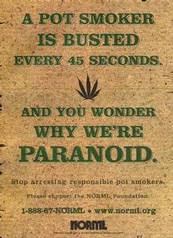 |
NORML POSTER AD. |
2. RULINGS OF CONSTITUTIONAL LAW. |
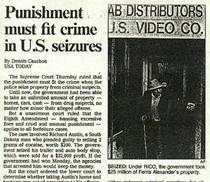 |
PUNISHMENT MUST FIT CRIME IN U.S.
SEIZURES.
"...a unanimous court ruled that the Eighth Amendment - banning excessive fines and cruel and unusual punishment - applies to all forfeiture cases." |
| Here are a couple of rulings in California CONSTITUTIONAL LAW, I found in the UCLA Law Library: (5) [&469] Possession of Marijuana (and Privacy). |
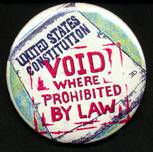 |
| In National Organization for Reform of
Marijuana Laws v. Gain (1979) 100 C.A.3d 586, 161 C.R. 181, individual taxpayers and an
organization brought an action against local law enforcement officials and
the district attorney, attacking sections of the Health and Safety Code that
prohibit the private possession and use of marijuana by adults. Following the
approach in Privitera (supra, &467), the court declared that the
California constitutional right of privacy "does not guarantee adult Californians the
privilege of smoking a possibly harmful drug, even in the privacy of their
homes." (100 C.A.3d 593.)
The ruling cited above as precedent from CA CONSTITUTIONAL LAW:
In People v. Privitera (1979) 23 C.3d
697, 153 C.R. 431, 591 P.2d 919, defendants were convicted of the felony of conspiracy to sell
and prescribe the unapproved drug laetrile for the alleviation or cure of
cancer. Held, freedom to obtain drugs of unproven efficacy (prohibited by
statutes and administrative regulations) is not within the right of privacy
guaranteed by the federal or California Constitutions. The United States
Supreme Court CURATOR'S NOTE: What we have in the above
ruling is the CA Court citing the federal right of privacy, that "important
decisions" falling within the right of privacy do not include medical treatment. There is
no federal
|
|
CALIFORNIA CONSTITUTION ARTICLE 1 DECLARATION OF RIGHTS All people are by nature free and independent and have inalienable rights. Among these are enjoying and defending life and liberty, acquiring, possessing, and protecting property, and pursuing and obtaining safety, happiness, and privacy.
*****
|
| CA CODE CIVIL CODE SECTION 1798.1
The Legislature declares that the right to privacy is a personal and fundamental right protected by Section 1 of Article 1 of the Constitution of California and by the United States Constitution. ***** |
| May 16, 2000. The U.S. Supreme Court
ruled today in a 5-4 decision that Congress overstepped it authority in allowing rape victims to
sue. What was interesting here is that the Court refused to allow Congress
free reign in the name of "interstate commerce." The
Violence Against Women Act of 1994 is unconstitutional, "Because the federal
government has no right
to regulate a private act, such as rape, that is neither part of
interstate commerce nor caused by state officials."
***** |
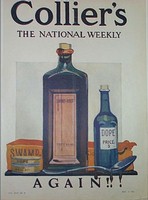 |
This 1912 magazine was printed the
year of the Harrison Narcotics Act, which rightly did not
include non-narcotic hemp products. This act
upheld the State's rights to determine drug policy. Hemp Museum framed magazine cover. |
| LETTER SUBMITTED TO THE LOS ANGELES TIMES: MAY
16, 2000. RE: High Court Ruling: Congress overstepped it authority. The U.S. Supreme Court took a big step toward overturning the war on drugs today when the Court declared, "...the federal government has no right to regulate a private act, such as rape (the same reasoning applies to smoking a joint for my own private use), that is neither part of interstate commerce (I grew it in my own back yard) nor caused by state officials." Congress has no power over "non-economic, violent criminal conduct" that does not cross state lines, said Chief Justice William H. Rehnquist. "The Constitution requires a distinction between what is truly national and what is truly local. "What does this say about Prop. 215 and its non-economic, non-violent, non-criminal conduct? California lawmakers ought to be ashamed for not knowing the national versus local distinction. They should pass hemp farming laws, medical freedom laws, and private use of pot laws immediately. Before the people have to again take the initiative. It’s their job. Richard M. Davis, Curator U.S.A. Hemp Museum ***** |
 |
Pictured (right) is an
honest-to-god government grown and rolled marijuana joint.
Lousy tasting and mostly leaf of poor quality pot, these joints
were given to patients on a trial program that ended abruptly
with 36 patients, of which 7 remain.
|
| We shall see how the conservative court ruled
when confronted with the
federally mandated "war on some drugs." Senate
Judiciary Committee Chairman Orrin G. Hatch (R-Utah) said, "The restoration of
federalism scrutiny in our federal courts is a welcome development in the
law. The Constitution reserves to the states the 'ordinary administration
of criminal and civil justice,'" he said, quoting Alexander Hamilton.
U.S. Supreme Court Chief Justice William H. Rehnquist echoed the words of Hamilton when he said, "the Founders denied the National government and reposed in the States...the suppression of violent crime and vindication of its victims."
***** |
 |
Stamps helped end the first prohibition. |
| Also under this section of rulings of law, see
U.S. V. BUTLER, 297, U.S. I, 1936, Plus Commentary. A quote from Butler from the Supreme Court of the U.S.: "The act invades the reserved rights of the states. It is a statutory plan to regulate and control agricultural production, a matter beyond the powers delegated to the federal government. " ***** |
| 3. MEDICAL MARIJUANA LAW.
Medical Cannabis was an agricultural crop, long before the big marijuana scare by the Treasury Department, and as such the federal government is prohibited by the Constitution from controlling Cannabis in any form by U.S. v. Butler above. [More on this later.] ***** |
| 4. INDUSTRIAL HEMP LAW.
THE U.N. LAW ON INDUSTRIAL HEMP. The U.N. Single Convention on Narcotic Drugs, 1961, Article 28, allows the planting of industrial hemp. This is the way many countries such as Canada are breaching the prohibition mentality. According to the U.S. Government classification of Cannabis, the Canadians are growing huge fields of marijuana. ***** |
| 5. MARIJUANA TAX ACT OF 1937. |
| The hearings on the Marijuana Tax Act of 1937, before the House Committee on Ways and Means, is 125 pages. Following is a greatly condensed version of maybe 4 or 5 pages. Thanks to James Dawson for this version from the original hemp museum. |
|
TAXATION OF
MARIHUANA HEARINGS BEFORE THE COMMITTEE ON WAYS AND MEANS HOUSE OF REPRESENTATIVES SEVENTY-FIFTH CONGRESS FIRST SESSION ON H.R. 6385 APRIL 27,28,29,30, AND MAY 4, 1937 TUESDAY, APRIL 27, 1937 The
term "marihuana: includes all parts of the plant
Cannabis sativa L., whether
growing or not; the seeds thereof; the resin extracted from
any part of such
plant; and every compound, manufacture, salt, derivative, mixture, or preparation of
such plant, its seeds, or resin; but shall not include
the mature stalks of such plant, or any product or
manufacture of such
stalks, except the resin extracted there from and any
compound, THE PURPOSE OF H.R. 6385 IS TO EMPLOY THE FEDERAL TAXING POWER NOT ONLY TO RAISE REVENUE FROM THE MARIHUANA TRAFFIC, BUT ALSO TO DISCOURAGE THE CURRENT AND WIDESPREAD UNDESIRABLE USE OF MARIHUANA BY SMOKERS AND DRUG ADDICTS AND THUS DRIVE THE TRAFFIC INTO CHANNELS WHERE THE PLANT WILL BE PUT TO VALUABLE INDUSTRIAL, MEDICAL, AND SCIENTIFIC USES. IN ACCOMPLISHING THIS GENERAL PURPOSE TWO OBJECTIVES SHOULD DICTATE THE FORM OF THE PROPOSED LEGISLATION: FIRST, THE DEVELOPMENT OF A SCHEME OF TAXATION WHICH WOULD RAISE REVENUE AND WHICH WOULD ALSO RENDER VIRTUALLY IMPOSSIBLE THE ACQUISITION OF MARIHUANA BY PERSONS WHO WOULD PUT IT TO ILLICIT USES WITHOUT UNDULY INTERFERING WITH THE USE OF THE PLANT FOR INDUSTRIAL, MEDICAL, AND SCIENTIFIC PURPOSES; AND SECOND, THE DEVELOPMENT OF AN ADEQUATE MEANS OF PUBLICIZING DEALINGS IN MARIHUANA IN ORDER THAT THE TRAFFIC MAY BE EFFECTIVELY TAXED AND CONTROLLED.(P.7) Since hemp fiber and articles manufactured there from are obtained from the harmless mature stalk of the plant, all such products have been completely eliminated from the purview of the bill by defining the term "marihuana" in the bill, so as to exclude from its provisions the mature stalk and its compounds or manufacturers. There are also some dealings in marihuana seeds for planting purposes and for use in the manufacture of oil which is ultimately employed by the paint and varnish industry. As the seeds, unlike the mature stalk, contain the drug, the same complete exemption could not be applied in this instance. but this type of transaction, as well as any transfer of completed paint or varnish products, has been exempted from transfer tax. Any negligible medical use which marihuana may have will also be left largely unrestricted by this bill.(p.8) This order form (for transfer) does not apply however to a transfer of marihuana by a practitioner to his patient, or by a druggist to a consumer who presents to the druggist a prescription issued by a practitioner registered under the act. Nor does it apply to exportations of marihuana, transfers of marihuana to Government officials, transfers to paint or varnish of which marihuana is an ingredient, transfers of marihuana to registered persons for use in the manufacture of paint or varnish and transfers of seeds of the marihuana plant.(p.9) In order to obviate the possibility of a similar attack upon the CONSTITUTIONALITY of this bill, it like the National Firearms Act, permits the transfer of marihuana to non registered persons upon the payment of a heavy transfer tax.(p.9) The Court repeated the rule that so long as a statute APPEARS upon its face to be a revenue measure, the Court cannot go behind the statute and inquire as to the motives which impelled Congress to enact it, although those motives may have been to REGULATE, rather than to raise revenue. (p.10) Mr. Anslinger: "...marihuana is the same as Indian hemp, and is sometimes found as a residual weed, and sometimes as the result of a dissemination of birdseed. It is known as cannabis, cannabis Americana, or cannabis Sativa. Marihuana is the Mexican term for cannabis Indica. We seem to have adopted the Mexican terminology, and we call it marihuana, which means GOOD-FEELING. (p.18) Mr. Anslinger: ..."At the Geneva Convention in 1895 the term "cannabis" included only the dried flowering or fruiting top of the pistillate plant as the plant source of the dangerous resin, from which the resin had not been extracted....we have urge the States to revise their definition so as to include all parts of the plant, as it now seems that the seeds and portions other than the dried flowering tops contain positively dangerous substances...as a matter of fact, the staminat leaves are about as harmless as a rattlesnake...this drug is entirely the monster Hyde."(p.19) Cannabis Indica is the medicinal preparation known to physicians. (p.22) Mr. Lewis: What is the
legitimate distribution of the drug. (The following statements were submitted by Mr. Anslinger) Marihuana
is the same as Indian hemp, hashish, cannabis, cannabis Americana, or cannabis
sativa. Marihuana is the Mexican term for cannabis indica. MARIHUANA
IS THE MEXICAN TERM FOR CANNABIS INDICA It is popularly known in India as Cannabis Indica; in America, as Cannabis americana, Cannabis indica, or Cannabis mexicana, in accordance with the geographical origin of the particular plant.(p.37) TAXATION OF MARIHUANA Mr. Hester: All legitimate users of marihuana are exempted from the provisions of this bill which imposes taxes upon transfers of marihuana and require such transfers to be made on order forms obtained from the collector of internal revenue, except purchasers of marihuana seeds for use in the making of bird seed, or marihuana seeds as bird seed, and purchasers of the flowering tops and leaves of marihuana for use in the making of the refined drug product. Those
legitimate users of marihuana who are exempted from these
transfer taxes and
order form requirements, are purchasers of the mature stalk
of marihuana for
use in the making of fiber products such as twine,
purchasers of
marihuana seeds for the further planting of marihuana and
the manufacture of
oil, and purchasers of such oil for use in the manufacture of paints and varnishes. STATEMENT OF DR. JAMES C. MUNCH, PHARMACOLOGIST, TEMPLE UNIVERSITY, PHILADELPHIA, PA. Dr.
Munch. Cannabis or marihuana was introduced into human
medicine by O'Shaughnessy
in 1838. (p.49) STATEMENT OF DR. LYSTER H. DEWEY, WASHINGTON, D.C. Dr.
Dewey. My name is Lyster H. Dewey. When I was in
the Department of ....there are different botanists who have seen the different forms of the plant and have given it different names, so far as its identity is concerned....there is only one species known as hemp. The term "hemp" is better known than marihuana because the name marihuana has been used only for the drug, while hemp is used in connection with the production of fiber. I was working with the fiber and not with the drug; that was incidental. STATEMENT OF HON. RALPH F. LOZIER, GENERAL COUNSEL FOR THE NATIONAL INSTITUTE OF OILSEED PRODUCTS. Mr. Lozier: May I say to this committee that, in my opinion, the measure before you is one which should not be hastily considered or hastily acted upon. It is of that type of legislation which conceals within its four corners activities, agencies, and results that this committee, without a thorough investigation, would never think were embodied in its measure (p.60)... If the committee please, the hemp seed, or the seed of the cannabis sativa L. is used in all the Oriental nations and also in a part of Russia as food. It is grown in their fields and used as oatmeal. Millions of people every day are using hemp seed in the Orient as food (p.61)... The point I make is this, that this bill is too all-inclusive. This bill is a world encircling measure. This bill brings the activities, the crushing of this great industry under the supervision of a bureau, WHICH MAY MEAN ITS SUPPRESSION... In the last 3 years there have been 193,000,000 pounds of hemp seed imported into this country, or an average of 64,000,000 pounds a year... Mr. Woodruff: What is the oil used for? Mr. Lozier: It is a drying oil, and its use is comparable to that of linseed oil or a perilla oil. It has a high iodine principle or strength. It is a rapidly drying oil to use in paints. It is also used in soap and in linoleum (p.61). Mr. Lozier: ...They manufacture this oil (hemp seed) and sell it in tank cars. They have been engaged in this business for years, and never until the last 3 weeks was any suggestion made that they were handling a commodity that was carrying a deleterious principle that was contributing to the delinquency of the people of the United States(p.63). FURTHER STATEMENT OF CLINTON M. HESTER, ASSISTANT GENERAL COUNSEL, TREASURY DEPARTMENT. Mr. Hester: ...Pursuant to your request yesterday afternoon we conferred with Judge Lozier and Mr. Williamson, and, also with Mr. MacDonald, Mr. Gordon, and Mr. Conners, and, as a result of our conference, those gentlemen, who represent importers of the seeds and those who crush the seeds for the purpose of making oil and using the residue of the seeds for making meal and cake, have expressed the view that they are willing to pay the occupational tax which is provided in this bell if the DEFINITION OF MARIJUANA IN THIS BILL IS AMENDED SO AS TO ELIMINATE OIL MADE FROM THE SEEDS, AND THE MEAL AND CAKE WHICH ARE MADE FROM THE SEEDS, AS WELL AS ANY COMPOUNDS OR MANUFACTURES OF EITHER OIL, MEAL, OR CAKE.....I see no objection to amending the definition of marihuana so as to eliminate oil, meal, cake, and the manufactured compounds of those materials. (p.68) AMENDMENTS TO H. R. 6358 Hempseed
oil, hempseed cake, hempseed meal, and all products
manufactured from
the above may be eliminated from the preview of the bill by
amending section
(b), which contains the definition of marihuana, to read as follows: The term
marihuana includes all parts of the plant Cannabis sativa L., whether growing or
not: the seeds thereof; the resin extracted from
any part of such plant; and every compound manufacture,
salt, derivative,
mixture, or preparation of such plant, its seeds or resin;
but shall not
include the mature stalks of such plant, oil, or cake made
from seeds, and
any compound, manufacture, salt, derivative, mixture, or preparation of such mature
stalks, oil or cake.....Since paints, varnishes, and
hempseed oil, under the definition as amended, will not be
included TAXATION OF MARIHUANA STATEMENT OF RAYMOND G. SCARLETT, REPRESENTING WILLIAM G. SCARLETT & CO., BALTIMORE, MD. We handle a considerable quantity of hempseed annually for use in pigeon feeds. That is a necessary ingredient in pigeon feed because it contains an oil substance that is a valuable ingredient of pigeon feed, and we have not been able to find any seed that will take its place...it has a tendency to bring back the feathers and improve the birds. There
has been an amendment proposed to section 1 (b) by
excluding from the definition of marihuana sterilized seed
which is incapable of germination, so
that section 1 (b), as so amended, would read as follows: Mr. Scarlett: Until Monday of this week we did not know there was any connection between the two i.e. hempseed and marihuana. When this bill came out and we saw that it was called a bill to impose an occupational excise tax upon dealers in marihuana we paid no attention to it. Nobody in the seed trade refers to hempseed as marihuana. Hempseed is a harmless ingredient used for many years in the seed trade. The trade at large do not know that this bill that is under consideration contains any provision affecting them, because the title of the bill would give them no knowledge that it was hempseed that was under discussion. (p.76) STATEMENT OF JOSEPH B..
HERTZSFELD, MANAGER, FEED DEPARTMENT, THE Hempseed is very beneficial because it adds the proper oil to the mixture of and promotes the growth of feathers; and it is also a general vitalizer. Birds lose their feathers and hempseed aids considerably in restoring the bird's vitality quickly. Otherwise there is a delay of 2 or 3 months before the bird gets back into condition, and the use of hempseed helps to accomplish that purpose.(p.77) Mr.
Hester: It is the ordinary field hemp growing wild, or at
least without the
extensive cultivation necessary to provide good fiber.
The committee may
have been confused because we have used the term marihuana
in this bill. In addition, I might say that some people say that the marihuana seed should be called fruit, because, botanically speaking, it is a fruit, not a seed. (p.78) Mr.
Reed: YOU WILL HAVE A REVOLUTION ON YOUR HANDS
if, as you say, this Mr. Dingell. Mr. Hester, do you not believe that the average farmer would be willing to use a mowing machine or a scythe if he thought that in that way or any way at all after a year or 2 years he could exterminate and KILL THE WEED WHICH KILLS PEOPLE? (p.83) Mr. Crowther. According to a brief that has been submitted, as a rule the addict passes into a dreamy state, in which judgment is lost, the imagination runs rampant; he is subject to bizarre ideas, lacking in continuity, and losing all sense of the measurement of time and space. (p.84) Mr.
Hester. ...we feel that we should submit to the
Secretary of the Treasury,
the question as to whether the Treasury Department would
object to the
proposed TAXATION OF MARIHUANA STATEMENT OF DR. WILLIAM C. WOODWARD, LEGISLATIVE COUNSEL, AMERICAN MEDICAL ASSOCIATION, CHICAGO, ILL. ....Unfortunately, I had no knowledge that such a bill as this was proposed until after it had been introduced Dr. Woodward. There is nothing in the medicinal use of Cannabis that has any relation to Cannabis addiction. I use the word "cannabis" in preference to the word "marihuana", because cannabis is the correct term for describing the plant and its products. THE TERM "MARIHUANA" IS A MONGREL WORD THAT HAS CREPT INTO THIS COUNTRY OVER THE MEXICAN BORDER AND HAS NO GENERAL MEANING, EXCEPT AS IT RELATES TO THE USE OF CANNABIS PREPARATIONS FOR SMOKING. It is not recognized in medicine, and I might say that is is hardly recognized even in the Treasury Department. I
have here a copy of a letter written by the Acting Secretary
of the Treasury,
April 15, 1937, in which he says: I
say the medicinal use of Cannabis has nothing to do with
Cannabis or marihuana
addiction. In all that you have heard here thus far,
no mention has
been made of any excessive use of the drug by any doctor or
its excessive
distribution by any pharmacist. And yet the burden of
this bill is
placed heavily on the doctors and pharmacists of
the country; and I may
say very heavily, most heavily, possibly
of all, on the farmers of The medicinal use of Cannabis, as you have been told, has decreased enormously....To say, however, as has been proposed here, that the use of the drug should be prevented by a prohibitive tax, loses sight of the fact that future investigation may show that there are substantial medical uses for cannabis. ...Indian
hemp has remarkable properties in revealing the
subconscious; hence
it can be used for psychological,
psychoanalytical, and psychotherapeutic
research, though only to a very limited extent... |
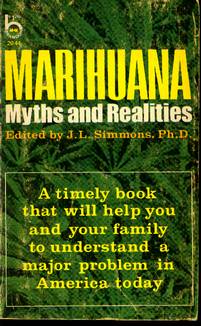 |
MARIJUANA: MYTHS AND REALITIES, Edited by J. L. Simmons, Ph.D. 1967. Brandon House, North Hollywood, CA. 239 Pages. Book size: 6 3/4 X 4 1/4 inches. On pages 160 &161 is the following summary of a look at the 1937 Tax Act. "IN THE MARKETPLACE OF FREE IDEAS: A Look At The Passage Of The Marihuana Tax Act" |
| By Joseph S. Oteri, Esq., L.L.B And
Harvey A. Silverglate., L.L.B.
"But the largest loophole in the Convention [Single Convention on Narcotic Drugs, United Nations, 1961], which entirely belies Mr. Anslinger's interpretation of the document, provides that while signatory nations are obligated to adopt measures to implement the aims of the Convention, that obligation is 'subject to (the) constitutional limitations' of each Party. (Emphasis supplied.) (Single Convention, Article 36-1.) Thus both the Congress and Mr. Anslinger, having long-ignored the pleas of medical men and scientists that they take a rational view of the problem, may someday find themselves embarrassed by a court's finding that the entire range of marijuana legislation violates one or more clauses of the United States Constitution. Perhaps the law is not 'locked up so tightly' after all. It would be a sharp blow to the legislative process and to the pride and reputation of legislative bodies if the present laws remain unexamined long enough to force a court to look at the facts and conclude that the marijuana laws were passed without any investigation into what is known by experts -sociologists, psychologists, psychiatrists, pharmacologists, and so forth. This might well happen when the concept of Due Process of Law is interpreted so as to require a legislature to look at the facts before it passes severe penal laws. Yet the legislatures, including the Congress of the United States, have thus far chosen to continue accepting the old well-worn myths propagated by men with no scientific objectivity or training. To those who were given a, perhaps, too rosy view of the legislative process in high school civics classes, it is probably surprising to see how, despite an increasingly loud debate on the medical effects of marijuana and on the wisdom, indeed the legality, of the Marijuana Tax Act, the 'spirit of '37' still prevails when 'the marketplace of free ideas' tries to gain entry into the legislative chambers of the nation." (pp.160-161.)
|
| I had a similar argument in my constitutional
challenge from Arizona:
"The totality of the arguments herein show present classification of Cannabis so erroneous that such classification is unreasonable, irrational, arbitrary and unconstitutional, and in violation of the equal protection and due process clauses of the Fourteenth Amendment of the United States Constitution and the Constitution of the State of Arizona..." (Davis v. Arizona.) Curator.
***** |
6. SOLUTIONS
|
| END PROHIBITION |
It's been done before in 1933 |
| A few years back I wrote the following initiative measure for California to end prohibition. It certainly should be adopted by the California Leaders, and if not by the people. With the 2001 power crisis upon us we need to press for acceptance of bio-mass energy crops, to fuel the 31 bio-mass generators in California that sit unused half the year for lack of fuel. |
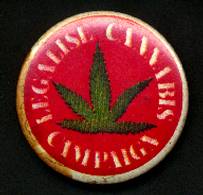 |
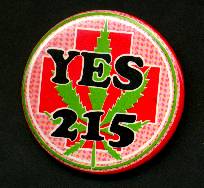 |
|
INITIATIVE MEASURE TO BE SUBMITTED
DIRECTLY TO TO THE HONORABLE SECRETARY OF THE STATE OF CALIFORNIA: We, the undersigned, registered, qualified voters of California, residents of the fore-described County (or City and County), hereby propose changes to the Health and Safety Code Sections 11357- 11362 relating to the Cannabis sativa plant by whatever name, and petition the Secretary of State to submit the same to the voters of California for their adoption or rejection at the next succeeding primary or general election or at any special statewide election held prior to that primary or general election or otherwise provided by law. The proposed statutory initiative reads as follows. THE CANNABIS SATIVA ACT OF 2000 A.D. THE PEOPLE OF THE STATE OF CALIFORNIA DO ENACT AS FOLLOWS: HEALTH AND SAFETY CODE SECTIONS 11357- 11362.
|
| SECTION 1. TITLE This initiative shall be known as the Cannabis sativa Act of 2000 A.D. SECTION 2. A. The People of the State of California find and declare that since the United States Federal Government is forbidden by law to control farm production as it has with the plant Cannabis sativa in California (see U.S. v. Butler, 297, U.S. I, 1936), has interfered with medical use of the plant Cannabis sativa under the Compassionate Use Act of 1996, in violation of the spirit and intent of the U.N. Single Convention Treaty, and has continually (from the U.S. Marijuana Tax Stamp Act of 1937, to the present) subjected us to silence on the benefits of Cannabis hemp, and the safety of medical Cannabis, while mounting the most pernicious campaign against the rights and privileges of California citizens who choose to use what is our inalienable right to use, plants given to us by the Creator, including the plant Cannabis sativa. B.. The People of the State of California find and declare that physicians, caregivers, producers and patients are continually being harassed, arrested and prosecuted for the recommendation, transportation, distribution and use of cannabis for medical purposes. C. The People of the State of California find and declare that the development and use of Cannabis sativa (hemp) as a basic natural renewable resource is in the best interest of the state economy and that the development of Cannabis sativa for the production of hemp and hemp products can be of tremendous medical, environmental and social advantage. D.. The People of the State of California find and declare that the safety of Cannabis sativa (no overdose deaths in recorded history, no toxicity), warrant removal of the plant from the Schedules of the Controlled Substances Act, thereby re-establishing Cannabis sativa as a free market agricultural resource. E. The People of the State of California find and declare that due to the safety and lack of toxicity and many medical applications of Cannabis sativa, the government is not warranted to invade the privacy of the family unit on adolescent use of Cannabis, unless due process is used. Control of Cannabis sativa use in the home is in the proper purview of parents or guardians of underage Californians. SECTION 3. PURPOSES A. Therefore, be it resolved that the People of California do hereby declare that the purpose of the Cannabis sativa Act of 2000 A.D. is to re-establish as an inalienable right of liberty of the people of California to use, grow, farm and develop economically the plant Cannabis sativa free of interference by the United States Federal Government, pursuant to the Ninth and Tenth Amendments to the Constitution of the United States. B. Therefore, be it resolved that the People of the State of California do hereby recognize the medical value of cannabis, and do hereby propose this Cannabis sativa Act of 2000 A.D. with the intent to authorize physicians to prescribe, pharmacists to dispense, producers to supply, and patients to use with or without a prescription Cannabis sativa for medical purposes, with the full protection of the law of the land given an inalienable right. SECTION 4. DEFINITION OF MEDICAL USE Medical use shall be defined as the personal consumption in any manner of any form of Cannabis sativa for any medical purpose as determined by an adult citizen of California or determined by the parent or guardian of underage Californians. This is an inalienable right of liberty for Californians. SECTION 5. EXCLUSION OF PRIOR ACTS The Cannabis sativa Act of 2000 A.D. shall be construed to repeal, delete, expunge, deny or abridge any California Statute or Code, criminal or civil, relating to the Cannabis sativa plant. SECTION 6. Any prescription issued by a licensed physician in the State of California for medical Cannabis shall conform to the standard format of a prescription and recommendations of medical Cannabis sativa for any medical purpose may be made as deemed appropriate by the physician or the patient, recognizing the inalienable right of the patient to the plant. SECTION 7. DISPENSING BY A PHARMACIST Any pharmacist licensed in the State of California may purchase, transport, store and dispense Cannabis sativa for the purpose of filling a prescription issued by a physician. All Cannabis sativa sold by licensed pharmacists must be organically produced in accordance with the California Organic Food Act of 1990. No special form or procedure shall be required of a pharmacist filling a prescription for Cannabis sativa. SECTION 8. ZONING RESTRICTIONS Zoning restrictions regarding the cultivation of Cannabis sativa for industrial purposes may be set forth by the proper authorities in the same manner as with any other food, agricultural or industrial enterprise. SECTION 9. FREEDOM FROM HARASSMENT (A) People engaged in the activities described in this Act shall be free from harassment by any and all authorities. (B) "Harassment" shall be defined as any act departing from the norm observed in the course of inspecting or supervising a commercial agricultural enterprise, including, but not limited to, aerial surveillance of a kind not customary to a commercial agricultural enterprise. SECTION 10. CEASING PROSECUTION, VACATING SENTENCES, RELEASING FROM PRISON, EXPUNGING OF RECORDS (A) Enactment of this initiative shall include: release from prison, jail, parole and probation, and clearing, expungement and deletion of all criminal records for all persons currently charged with, or convicted of any Cannabis sativa offenses included in this initiative which are hereby no longer illegal. (B) Evidence of criminal proceedings involving the plant Cannabis sativa which under this initiative are no longer illegal shall be expunged from a defendant’s record within 30 days of the passage of this Act. SECTION 11. LIBERAL CONSTRUCTION This Act is an exercise of the public power of the state for the protection of the health, safety, and welfare of the people of the State of California, and shall be liberally construed to effectuate these purposes. SECTION 12. SEVERABILITY The provisions of this Act are severable. If any provision of this Act or the application thereof to any person or circumstance is held invalid, that invalidity shall not affect any other provision or application of this Act which can be given effect without the invalid provision or application, and to this end the provisions of this Act are severable. SECTION 13. CONFLICTING MEASURES |
| If this measure is approved by the voters but
superseded by any other conflicting ballot measure approved by more voters at the same election, and
the conflicting ballot measure is later held invalid, it is the intent of the
voters that this Act shall be self-executing and given full force of the law.
SECTION 14. EFFECTIVE DATE This Act shall become effective immediately upon its approval by the voters. SECTION 15. SELF-EXECUTION This Act shall be self-executing. SECTION 16. AMENDMENT This Act shall not be altered or amended except by a vote of the people. ***** |
| 9. THE CASE OF ALASKA. |
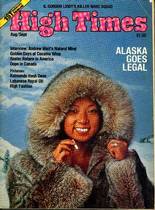 |
HIGH TIMES: Aug/Sept, 1974. ALASKA GOES LEGAL. The case of Ravin v. State of Alaska, 1974, led the Alaska Supreme Court to rule that growing and smoking Cannabis was protected in home and yard by the State Constitution's right to privacy. This remains the law today. In other words, half a million Americans can light up a joint without fear of arrest, while the rest of us are at risk of jail. Who said the federal government was in charge of drug policy? Not in Alaska, and not for the last 30 years has the federal government been able to do anything about it. |
10. 872,721 Marijuana Arrests In 2007 = Government Insanity
14. CURATOR'S CONSTITUTIONAL CHALLENGE
16. State Medical Marijuana Laws Not Preempted by Federal Law says U.S. Supreme Court
If you would like to join the USA Hemp Museum
or communicate with the curator, send an
email to
Richard M. Davis:
Curator, Founder, Author
Help support the USA Hemp Museum -
Please Make A
Donation
To The USA Hemp Museum's Building Fund
So We Can Make Public Our Collection
Of
Over 1,700 Hemp History Items
and/or buy the books
|
Richard M. Davis |
|
|
